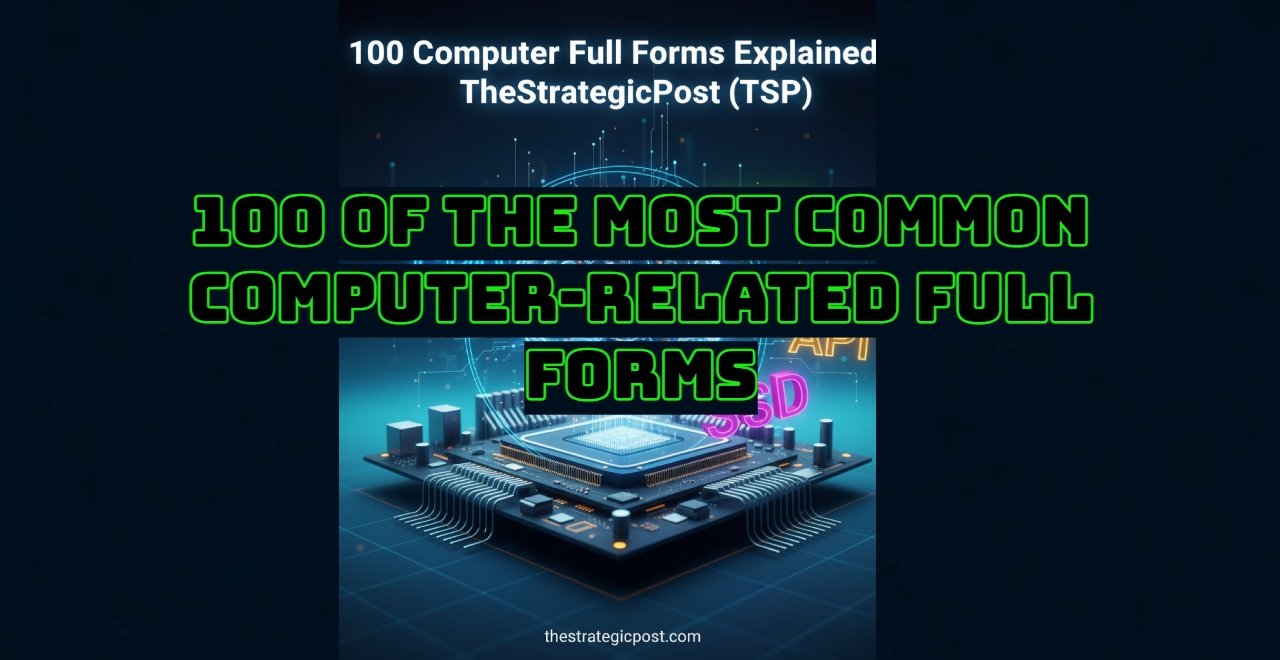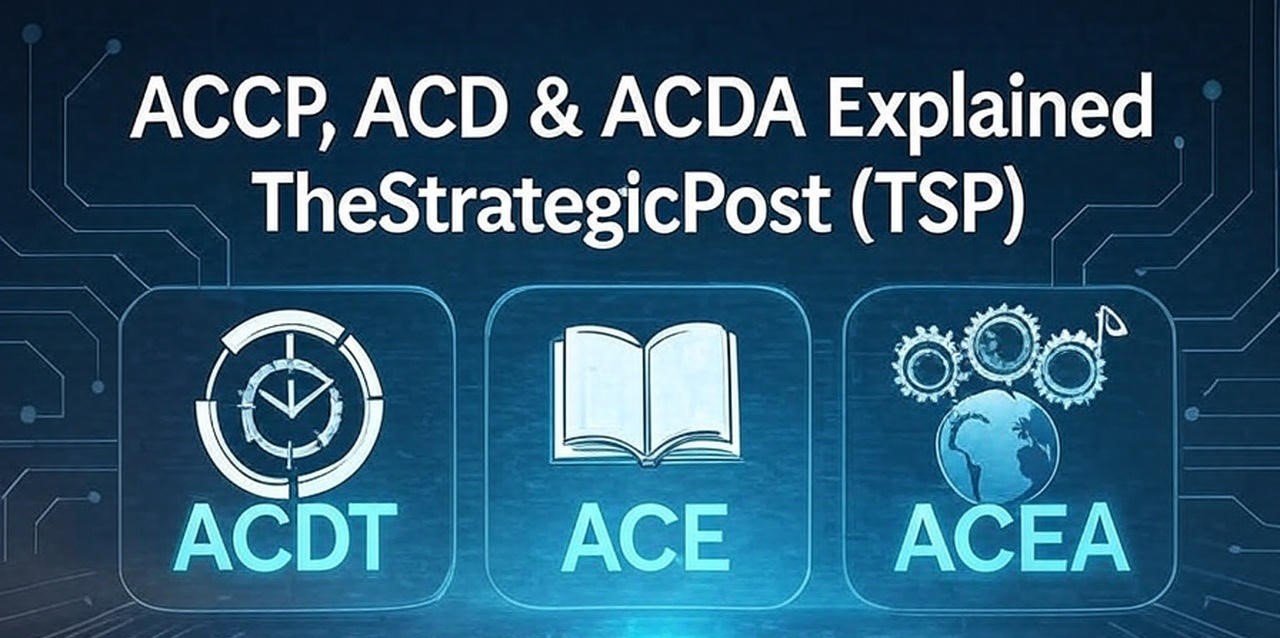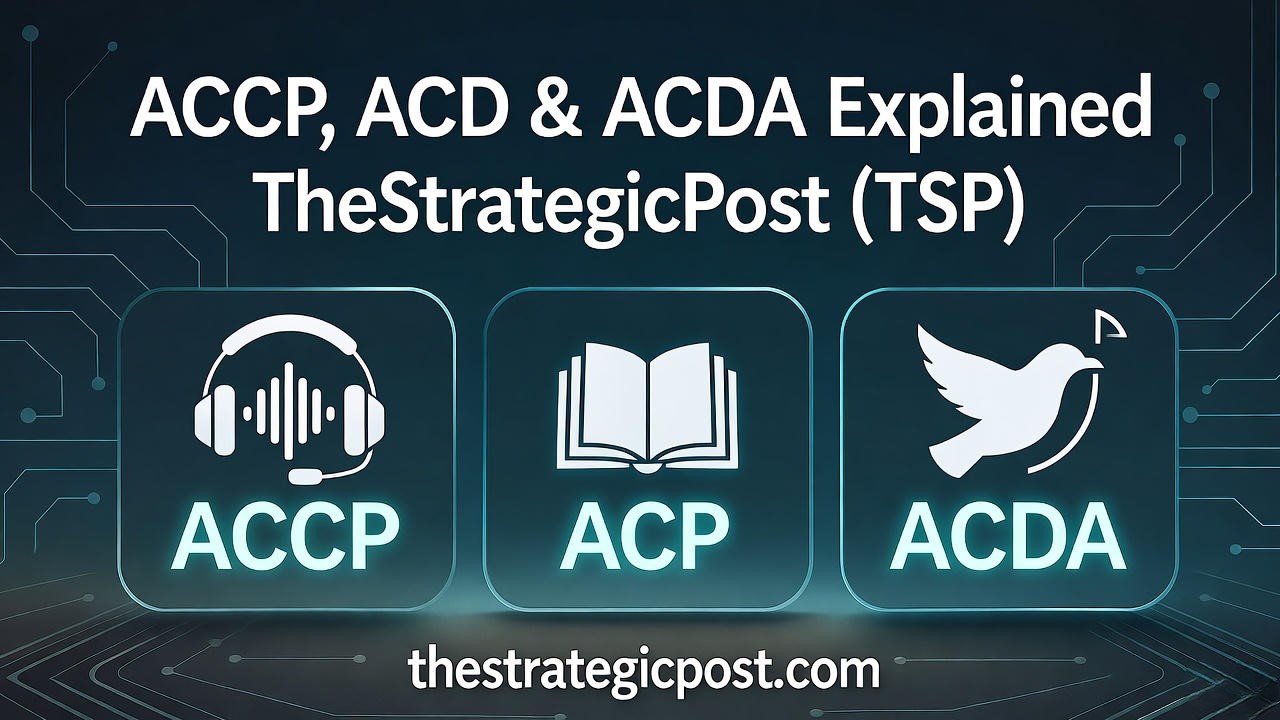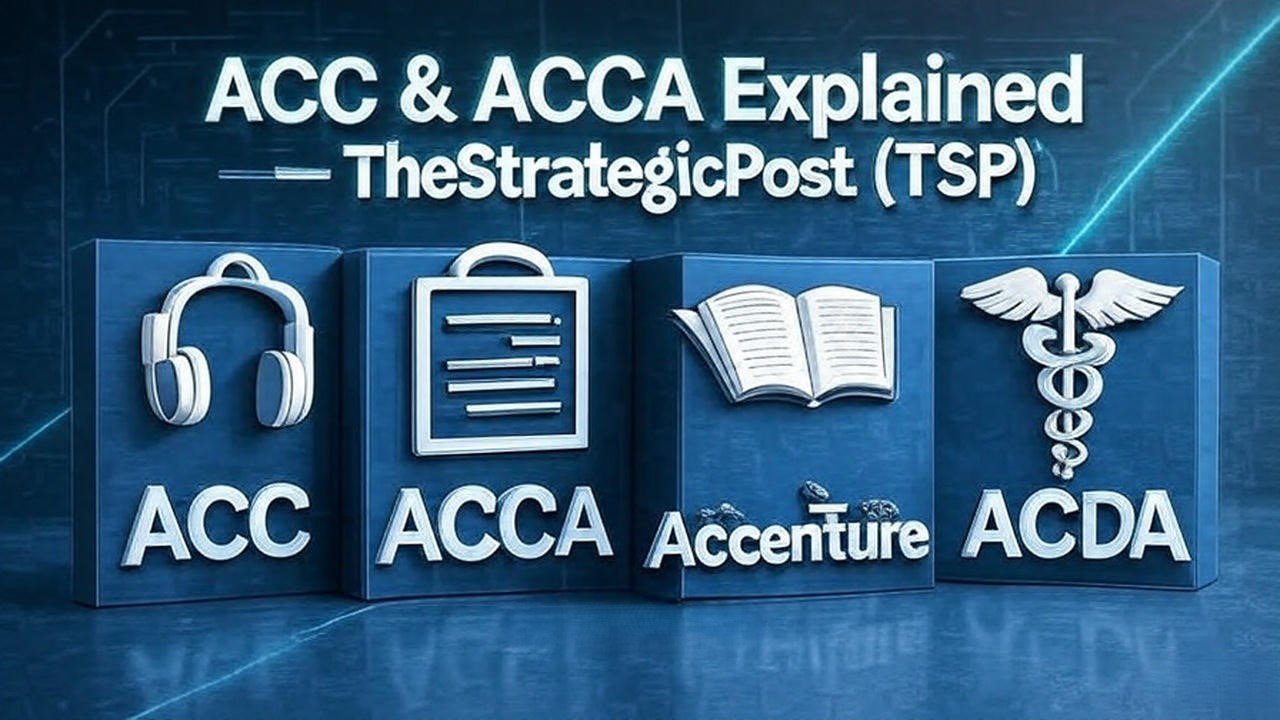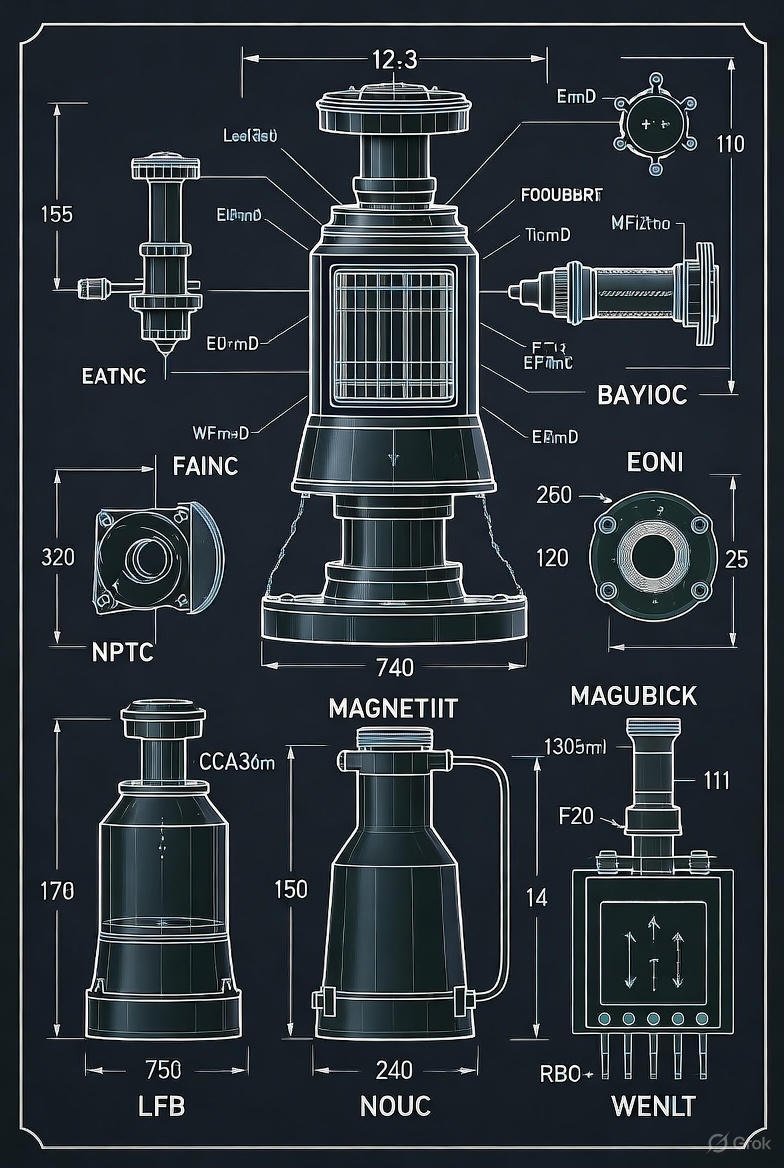Table of Contents
100 Common Full Forms and Their Definitions in Computer — TheStrategicPost (TSP)
Explore 100 essential computer full forms and definitions across hardware, software, networking, and programming. A complete TSP guide for students, tech learners, and professionals.
💻 Introduction
In the fast-evolving world of technology, computers have become the backbone of modern civilization. But with every innovation comes an ocean of acronyms and abbreviations — from CPU and RAM to API and AI.
This guide by TheStrategicPost (TSP) brings together 100 of the most common computer-related full forms, neatly categorized and simplified for learners, IT professionals, and digital enthusiasts.
Whether you’re preparing for an exam, working in IT, or simply curious about the language of technology — this comprehensive glossary will strengthen your foundation.
🧾 100 Common Computer Full Forms and Their Meanings
| No. | Acronym | Full Form | Definition / Meaning |
|---|---|---|---|
| 1 | CPU | Central Processing Unit | The brain of the computer, responsible for executing instructions. |
| 2 | RAM | Random Access Memory | Temporary storage that provides fast read/write access for running processes. |
| 3 | ROM | Read-Only Memory | Non-volatile memory storing firmware and boot instructions. |
| 4 | HDD | Hard Disk Drive | Magnetic storage device used for storing data permanently. |
| 5 | SSD | Solid State Drive | Faster flash-based storage with no moving parts. |
| 6 | USB | Universal Serial Bus | A standard connector for peripherals and data transfer. |
| 7 | GUI | Graphical User Interface | Interface allowing users to interact via icons and visuals. |
| 8 | CLI | Command Line Interface | Text-based interface where users input commands directly. |
| 9 | LAN | Local Area Network | Connects computers within a small area like an office or home. |
| 10 | WAN | Wide Area Network | Connects multiple LANs over large distances. |
| 11 | HTTP | Hypertext Transfer Protocol | Transfers web data between client and server. |
| 12 | HTTPS | Hypertext Transfer Protocol Secure | Secure encrypted version of HTTP. |
| 13 | IP | Internet Protocol | Defines addressing and routing of data packets. |
| 14 | TCP | Transmission Control Protocol | Ensures reliable data transmission over networks. |
| 15 | UDP | User Datagram Protocol | Faster, connectionless alternative to TCP. |
| 16 | URL | Uniform Resource Locator | The web address of a resource on the Internet. |
| 17 | HTML | Hypertext Markup Language | Standard language for creating web pages. |
| 18 | CSS | Cascading Style Sheets | Controls the layout and design of web pages. |
| 19 | XML | Extensible Markup Language | Flexible format for storing and transporting data. |
| 20 | SQL | Structured Query Language | Used for managing and querying databases. |
| 21 | DBMS | Database Management System | Software that organizes and manages databases. |
| 22 | OS | Operating System | Manages computer hardware and software resources. |
| 23 | AI | Artificial Intelligence | Machines simulating human intelligence and behavior. |
| 24 | ML | Machine Learning | AI subset enabling systems to learn from data. |
| 25 | IoT | Internet of Things | Network of interconnected physical devices sharing data. |
| 26 | ISP | Internet Service Provider | Company providing internet connectivity. |
| 27 | DNS | Domain Name System | Converts domain names into IP addresses. |
| 28 | VPN | Virtual Private Network | Secures internet traffic by encrypting connections. |
| 29 | FTP | File Transfer Protocol | Transfers files between computer systems. |
| 30 | WLAN | Wireless Local Area Network | Wireless version of LAN using Wi-Fi signals. |
| 31 | MAC | Media Access Control | Unique hardware address of a network device. |
| 32 | NAT | Network Address Translation | Allows multiple devices to share one IP address. |
| 33 | RDP | Remote Desktop Protocol | Enables remote graphical access to another computer. |
| 34 | SSL | Secure Sockets Layer | Protocol for encrypted communication over the internet. |
| 35 | TLD | Top-Level Domain | The last segment of a domain (.com, .net, etc.). |
| 36 | SMTP | Simple Mail Transfer Protocol | Protocol used for sending emails. |
| 37 | IMAP | Internet Message Access Protocol | Retrieves and syncs emails across devices. |
| 38 | POP3 | Post Office Protocol 3 | Downloads emails from the server to local storage. |
| 39 | VoIP | Voice over Internet Protocol | Enables voice calls over the internet. |
| 40 | BSoD | Blue Screen of Death | Windows error screen after a fatal crash. |
| 41 | DOS | Disk Operating System | Early text-based OS used before Windows. |
| 42 | VGA | Video Graphics Array | Display standard for monitors. |
| 43 | GIF | Graphics Interchange Format | Image format supporting animation. |
| 44 | JPEG | Joint Photographic Experts Group | Image compression format for digital photos. |
| 45 | PNG | Portable Network Graphics | Lossless compressed image format. |
| 46 | Portable Document Format | Universal file format for documents. | |
| 47 | CAD | Computer-Aided Design | Used to design precision drawings or 3D models. |
| 48 | ERP | Enterprise Resource Planning | Integrates business management processes. |
| 49 | CRM | Customer Relationship Management | Manages customer interactions and data. |
| 50 | API | Application Programming Interface | Allows software systems to communicate. |
| 51 | SDK | Software Development Kit | Tools used to develop applications. |
| 52 | IDE | Integrated Development Environment | Combines tools for writing and debugging code. |
| 53 | JSON | JavaScript Object Notation | Lightweight format for data exchange. |
| 54 | PHP | Hypertext Preprocessor | Server-side scripting language for web development. |
| 55 | ASP | Active Server Pages | Microsoft’s web application framework. |
| 56 | MVC | Model-View-Controller | Architectural pattern for web apps. |
| 57 | RSS | Really Simple Syndication | Feeds updates from websites automatically. |
| 58 | W3C | World Wide Web Consortium | Organization developing web standards. |
| 59 | TLS | Transport Layer Security | Encryption protocol for secure communication. |
| 60 | JS | JavaScript | Language for creating interactive web content. |
| 61 | AJAX | Asynchronous JavaScript and XML | Enables dynamic web updates without reloading. |
| 62 | SEO | Search Engine Optimization | Improves website visibility in search engines. |
| 63 | SMB | Server Message Block | Protocol for sharing files and printers on a network. |
| 64 | SaaS | Software as a Service | Cloud-based software delivery model. |
| 65 | PaaS | Platform as a Service | Cloud model offering tools for app development. |
| 66 | IaaS | Infrastructure as a Service | Provides virtualized computing resources online. |
| 67 | DDoS | Distributed Denial of Service | Attack that overwhelms servers with traffic. |
| 68 | DRM | Digital Rights Management | Protects digital media from unauthorized use. |
| 69 | WAP | Wireless Application Protocol | Enables mobile devices to access internet data. |
| 70 | NFC | Near Field Communication | Allows close-range wireless data exchange. |
| 71 | OCR | Optical Character Recognition | Converts scanned text into editable data. |
| 72 | VLAN | Virtual Local Area Network | Logically separates network devices on the same LAN. |
| 73 | XSS | Cross-Site Scripting | Security flaw allowing malicious scripts in web apps. |
| 74 | ZIP | Zone Improvement Plan | U.S. postal code system (used digitally for compression too). |
| 75 | WEP | Wired Equivalent Privacy | Early Wi-Fi security standard. |
| 76 | ASCII | American Standard Code for Information Interchange | Character encoding standard using binary. |
| 77 | GHz | Gigahertz | CPU speed unit = 1 billion cycles per second. |
| 78 | MIPS | Million Instructions Per Second | Measures processor speed. |
| 79 | BCD | Binary Coded Decimal | Represents decimal numbers in binary form. |
| 80 | BIT | Binary Digit | Smallest unit of digital data (0 or 1). |
| 81 | CD | Compact Disc | Optical disc for storing data. |
| 82 | PSU | Power Supply Unit | Converts AC to DC for computer components. |
| 83 | WORM | Write Once Read Many | Storage medium that cannot be overwritten. |
| 84 | MODEM | Modulator-Demodulator | Converts digital to analog signals and vice versa. |
| 85 | CRT | Cathode Ray Tube | Old display technology used in monitors. |
| 86 | LCD | Liquid Crystal Display | Flat display using liquid crystals. |
| 87 | LED | Light Emitting Diode | Semiconductor light source for displays and lighting. |
| 88 | CU | Control Unit | Directs data flow within the CPU. |
| 89 | ALU | Arithmetic Logic Unit | Performs arithmetic and logic operations. |
| 90 | CPS | Characters Per Second | Measures printer speed. |
| 91 | FORTRAN | Formula Translation | Programming language for scientific computing. |
| 92 | COBOL | Common Business Oriented Language | Early language designed for business apps. |
| 93 | SMTP | Simple Mail Transfer Protocol | Used to send and route email messages. |
| 94 | JSP | JavaServer Pages | Java technology for dynamic web content. |
| 95 | LSD | Least Significant Digit | Rightmost digit of a number. |
| 96 | MSD | Most Significant Digit | Leftmost digit of a number. |
| 97 | CUI | Character User Interface | Text-based interface similar to CLI. |
| 98 | GPU | Graphics Processing Unit | Handles rendering and graphical computations. |
| 99 | BIOS | Basic Input Output System | Firmware that starts hardware initialization. |
| 100 | DNS | Domain Name System | Translates website names into numerical IPs. |
🌐 Why Learn These Computer Full Forms?
Understanding these full forms isn’t just for exams — it’s for clarity, confidence, and communication in technology.
When you know the meaning behind technical terms, you:
- Decode documentation faster
- Improve your digital literacy
- Understand how systems work internally
- Enhance your professional language in IT and development
❓ Frequently Asked Questions (FAQs)
Q1. What is the most important computer full form to know?
The most essential one is CPU — Central Processing Unit, as it’s the core component of all computing devices.
Q2. What are common internet-related full forms?
Examples include IP, DNS, HTTP, VPN, and URL — all vital for web communication.
Q3. Which full forms are important for programmers?
Programmers often use API, IDE, JSON, PHP, and MVC daily.
Q4. What are hardware-related full forms?
HDD, SSD, RAM, ROM, CPU, GPU, and PSU are key hardware components.
Q5. Which networking full forms should students memorize?
Focus on LAN, WAN, MAC, NAT, DNS, and VPN for strong networking fundamentals.
🧩 Conclusion
The digital world thrives on abbreviations — each representing a core principle of technology.
This TSP Full Form Dictionary helps learners, developers, and enthusiasts navigate the dense web of terms that define the modern computing ecosystem.
Stay tuned for upcoming editions of “Tech Full Forms Series” by TheStrategicPost, where we’ll decode every alphabet in the language of technology — one post at a time.

